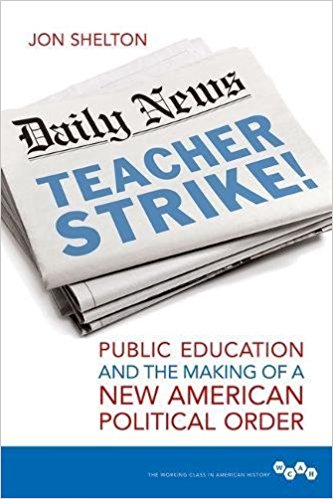Teacher Strike! Public Education and the Making of a New American Political Order
Teacher Strike! Public Education and the Making
of a New American Political Order
by Jon Shelton (Urbana: University of Illinois Press, 2017)
Reviewed by Professor Robert D. Parmet, York College of the City University of New York, a member of the Executive Board of the New York Labor History Association.
The mice roared. In the 1960s, American public school teachers gained renewed interest in collective bargaining, and frequently went on strike for their labor rights. With private sector union membership at a high level in the mid-1950s, and blue-collar workers enjoying relative prosperity, teachers increasingly believed that collective bargaining could benefit them as well. Such action could reap high salaries, small class sizes, respectful administrators, and secure jobs. These rewards would also bring about the middle-class status that other professionals enjoyed.
The teachers’ goals coincided with those of the civil rights movement, which aimed, among other things, to eradicate racial inequality and inner city poverty. In this spirit arose “a new generation of teachers,” less conformist and respectful of authority than their predecessors, but more activist. Nevertheless, similar to private sector employees, their primary focus was mainly on “bread-and-butter” issues.
As Jon Shelton observes in Teacher Strike!, the educators combined with civil rights, liberal and corporate leaders to form a “labor-liberal coalition.” This militancy produced “300 teacher strikes in the 1960s” and “more than 200 in the 1975-76 school year,” in such cities as Philadelphia, Chicago, New York, Detroit, and Pittsburgh.
Opposition “producerists,” as Shelton calls them, were aghast at such conduct. Described by the author as “many white working- and middle-class Americans and corporate interests,” they “imagined themselves as the only legitimate ‘productive’ contributors to society.” Alleging that “both public employees and the urban poor flouted the law,” the critics preached a “neoliberalism” that moved national politics to the right, separate and distinct from labor liberalism.
Shelton, an assistant professor of democracy and justice studies at the University of Wisconsin Green Bay, explains this shift with a detailed examination of the local sentiments and politics that ultimately transformed the national scene. His organization is largely chronological and straightforward. He begins by discussing the social and economic reforms of the New Deal, which notably left public employees unprotected, and then reviews the roots of teacher unionization. In a neatly crafted summary, he reaches back to the Chicago Teachers’ Federation in 1857 before noting more recent developments, such as the ill effects on teacher unions of America’s two postwar Red Scares. Shrewdly avoiding the familiar path of teacher social history, he concentrates on the educators as public employees. Buttressed by numerous published and primary sources, his discussion touches upon race relations.
In chapters on Philadelphia, New York, Chicago and elsewhere, Shelton clearly reveals that teacher strikes fractured urban communities, often creating significant public backlash. For example, in the Ocean Hill-Brownsville section of Brooklyn in 1968 and Newark in 1970, Black Power and the issue of community control of the public schools produced intense racial friction. In a 1971 strike, Newark, New Jersey blacks and whites “split along racial lines,” and “almost half of the city’s teaching force crossed the picket lines.”
Five years later, New York City nearly went bankrupt. According to President Gerald R. Ford, the crisis stemmed from the benefits provided by excessive labor liberalism, especially to municipal employees, university students, and welfare recipients. Years later scholarly historians such as Joshua B. Freeman (2012) and Kim Phillips-Fein (2017) rebutted that charge, but in 1975 “a cacophonous debate” identified a “primary culprit,” “the city’s unionized workforce—especially the teachers.” It was a case in which the “white middle-class American man . . . was victimized by a liberal state allied with the excessive demands of African Americans and teachers.”
Shelton proceeds to discuss teacher strikes in Pittsburgh, St. Louis and Philadelphia. Long-standing resentments against teachers and other municipal employees commonly came to the surface along with the image of the “fed-up taxpayer.” By embracing this discontent, the author argues, right-wing politicians urged “a return to the classical liberalism of the nineteenth century.” Overlooking the neediest children, they promoted “individual competition in the marketplace” rather than “collective organization or social policy.” Privatization in the form of charter schools and school vouchers, and increased attention to private schools, subverted public education. Shelton presents the argument for vouchers, initially made by economist Milton Friedman in a 1955 essay, continued by neoliberals in the 1960s and 1970s and in the Philadelphia teachers’ strike of 1981, and still very much alive. So, too, is the case for charter schools, as made by former District of Columbia schools chancellor Michelle Rhee, which he mentions, but does not fully explore. Similarly, he says little about retirement plans, other than to note that President Gerald R. Ford and other critics cited public employee pensions when they placed blame for the 1975 New York fiscal crisis.
Therefore, as Jon Shelton argues with ample documentation, over the past half century many Americans shifted from labor liberalism to neoliberalism, which included opposition to teacher activism. This shift changed the nation’s politics, opening “new space for powerful corporate interests . . . to radically alter the trajectory of American political economy.” In other words, this development has been felt well beyond the classroom.

